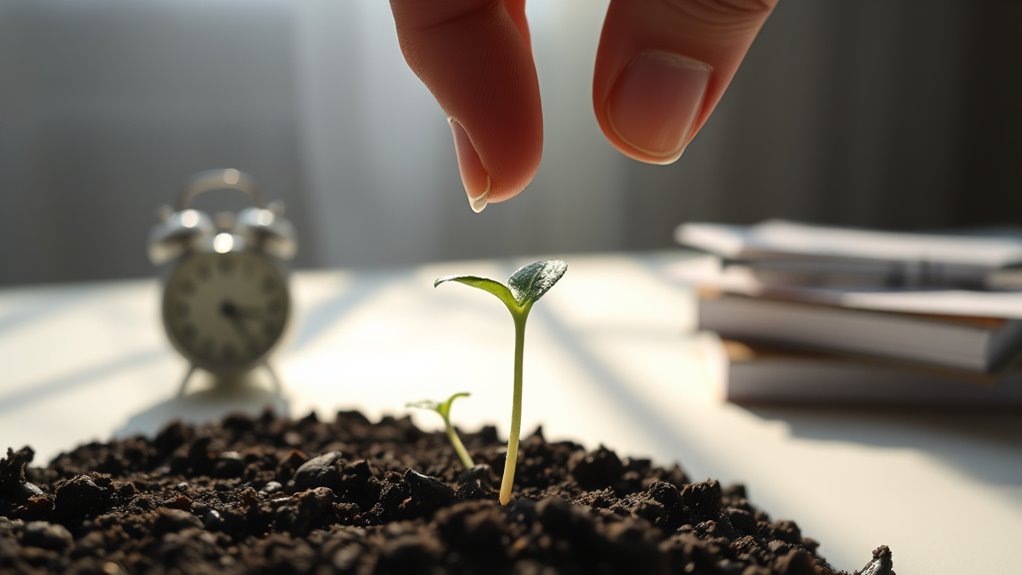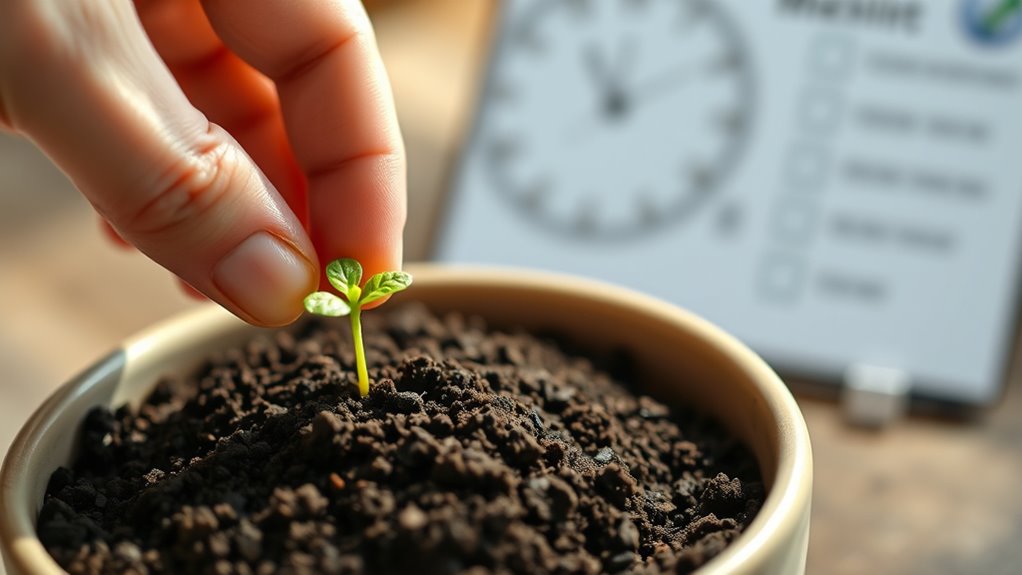Habit Building
The Two‑Minute Rule: How Quick Wins Build Lasting Habits
Weirdly, mastering the Two-Minute Rule can unlock lasting habits by turning small wins into powerful routines that…

The Two-Minute Rule helps you build lasting habits by encouraging you to start with small, easy tasks you can do in just two minutes. These quick wins reduce overwhelm, boost your confidence, and create momentum for bigger changes. Using habit stacking and environmental cues makes it even easier to stay consistent. Keep going, and you’ll discover how these simple steps can transform your routines and help you achieve lasting success.
Key Takeaways
- Completing tasks in under two minutes reduces procrastination and encourages consistent action.
- Small wins boost motivation and create momentum for building larger habits over time.
- The rule simplifies habits, making them easier to start and sustain through quick, manageable steps.
- Combining the two-minute rule with habit stacking and cues enhances automatic behavior formation.
- Focus on frequent, tiny successes cultivates long-term change by reinforcing positive routines.

Have you ever struggled to tackle small tasks that pile up and seem overwhelming? It’s a common problem, especially when tasks feel insignificant on their own but add up over time. That’s where the two-minute rule comes in—by focusing on quick, manageable actions, you can start building momentum for bigger habits. The key is to make these tiny tasks so easy that you can’t say no. Once you get started, you often find yourself doing more than you initially intended. This simple approach can turn into a powerful tool for lasting change.
Small tasks feel overwhelming; start with quick, easy actions to build lasting habits and momentum.
One effective way to implement this is through habit stacking. It’s about linking a new, small habit to something you already do regularly. For example, if you already brush your teeth every morning, you can add a two-minute activity immediately afterward, like jotting down your goals or tidying up your workspace. Because the new task is linked to an existing routine, it becomes easier to remember and integrate into your daily life. Habit stacking leverages environmental cues—those little signals in your surroundings that prompt behavior—to trigger your new habit naturally. For instance, placing a trash bag near your desk can cue you to take out the trash right after work, or leaving your workout clothes by your bed can remind you to exercise in the morning. These cues make it effortless to act without relying solely on willpower.
In addition, practicing mindfulness or stillness during these small tasks can significantly enhance your self-awareness and emotional balance, making it easier to sustain positive habits. The beauty of the two-minute rule is that it minimizes resistance. When a task takes less than two minutes, you’re less likely to put it off. This creates an immediate sense of accomplishment, which reinforces the habit and motivates you to do more. Over time, those small wins add up, leading to bigger changes. You might start with just two minutes of stretching every morning or five minutes of organizing your email inbox. Once those small actions become routine, they naturally expand into longer sessions or more complex tasks. The key is consistency, not intensity. By focusing on quick wins and using environmental cues to trigger them, you set a foundation for sustainable habits that require minimal effort but yield significant results.
In essence, the two-minute rule transforms overwhelming tasks into manageable steps. When combined with habit stacking and strategic environmental cues, it creates a system where positive behaviors become automatic parts of your life. You’ll find that what once seemed like a mountain of chores can be broken down into small, doable chunks that gradually build into lasting habits. It’s about making change simple, accessible, and sustainable—one two-minute task at a time.
Frequently Asked Questions
Can the Two-Minute Rule Be Applied to Complex Tasks?
Yes, you can apply the two-minute rule to complex tasks by scaling complexity and breaking barriers into smaller, manageable steps. Start with tiny actions that take only two minutes, which helps you overcome initial resistance. As you build momentum, gradually tackle more challenging parts. This approach makes even complex tasks feel achievable, encouraging consistent progress and helping you develop lasting habits through small, steady wins.
How Do I Stay Motivated With Small Initial Habits?
To stay motivated with small initial habits, focus on intrinsic motivation by reminding yourself why the habit matters to you. Celebrate each win to reinforce the habit, making it feel rewarding. When you see progress, it boosts your confidence and keeps you engaged. Remember, consistent small steps create momentum, so stay patient and persistent. Habit reinforcement gradually makes the behavior automatic, fueling your motivation to continue.
What if I Miss a Day Practicing the Two-Minute Rule?
If you miss a day practicing the two-minute rule, don’t get discouraged. Instead, use accountability partners or habit tracking to stay on track. Acknowledge the slip, then pick up where you left off without guilt. Consistency matters more than perfection, so focus on resuming your habit. These tools help you stay motivated, making it easier to bounce back and keep building your habits steadily.
Does the Rule Work for Long-Term Goal Achievement?
Yes, the Two‑Minute Rule works for long-term goal achievement because it promotes habit formation and sustainability. By focusing on small, manageable actions, you build consistency over time, making habits easier to sustain. Even if you miss a day, it doesn’t derail your progress. Keep the focus on daily effort, and you’ll develop lasting habits that support your long-term goals without feeling overwhelmed or discouraged.
How Can I Adapt the Rule for Group or Team Habits?
You can adapt the Two-Minute Rule for team habits by setting small, immediate tasks that promote team accountability and collective motivation. Encourage everyone to commit to quick, manageable actions that integrate into daily routines. When team members see quick wins, they stay motivated and accountable, reinforcing positive habits together. Use regular check-ins to celebrate these wins, maintaining momentum and fostering a culture of continuous improvement.
Conclusion
By applying the two-minute rule, you’re more likely to turn small actions into lasting habits. Did you know that it takes an average of 66 days to form a new habit? Starting with just two minutes makes the process manageable and less intimidating. Over time, those quick wins add up, creating momentum that keeps you going. So, commit to that tiny step today—you’ll be surprised how quickly it transforms your routines.
Habit Building
Habit Stacking 2025: Integrating New Routines Into Existing Patterns
Cleverly integrating new habits into your daily routine in 2025 can transform your life—discover how to make change effortless and lasting.

In 2025, mastering habit stacking means integrating new routines into your existing patterns effortlessly. By linking behaviors to familiar activities—like meditating after brushing your teeth—you make new habits feel natural and easy to stick with. Focus on small, manageable actions that align with your daily rhythm, and personalize triggers to suit your lifestyle. If you keep exploring, you’ll discover how to create seamless routines that support your goals and make lasting change second nature.
Key Takeaways
- Link new habits to established routines to minimize effort and increase automaticity.
- Use natural triggers, like brushing teeth or coffee breaks, to seamlessly integrate new behaviors.
- Personalize habit stacks based on individual preferences and daily patterns for better adherence.
- Start with simple, manageable actions to build confidence and gradually increase complexity over time.
- Regularly review and adapt routines to ensure they remain relevant and effectively support your goals.

As habits become more central to our daily routines, habit stacking in 2025 offers a powerful way to build lasting change with minimal effort. By linking new behaviors to existing routines, you can seamlessly integrate positive habits into your life without feeling overwhelmed. To do this effectively, understanding motivational strategies is key. When you connect a new habit to something you already do regularly, it taps into your natural routines, making the new action feel more automatic and less like a chore. For instance, if you want to start journaling, you might choose to do it immediately after brushing your teeth, leveraging your existing habit as a trigger. This approach boosts motivation because it reduces the mental resistance often associated with starting something new. Incorporating keto-friendly ingredients into your routines can also support your health goals without adding extra complexity to your day.
Habit customization plays an essential role here. Not every strategy works universally, so tailoring your habit stacks to fit your personal preferences and daily patterns ensures greater success. Maybe you’re more motivated in the morning, so you choose to do your new habit first thing, or perhaps you prefer evening routines. Customizing your habit stacks means selecting triggers and routines that naturally fit into your lifestyle, increasing the likelihood of consistency. You might also experiment with different combinations—pairing a quick meditation with your coffee break or stretching exercises with your commute—to discover what feels most intuitive and sustainable.
To maximize effectiveness, keep your habit stacks simple and manageable. Start with small, achievable actions that require minimal effort but create a sense of accomplishment. Over time, as these routines become ingrained, you can gradually increase their complexity or duration. Remember, the goal is to make your new habits feel like a natural extension of your existing behaviors, not a disruptive addition. Regularly review your stacks and make adjustments as needed—what works in one season might not in another. Flexibility guarantees your habit stacks remain relevant and effective, especially as your routines evolve.
In essence, habit stacking in 2025 is about smart integration. Use motivational strategies to stay inspired and habit customization to ensure your routines suit your life. When you approach this method with patience and a willingness to adapt, you’re setting yourself up for sustainable change that feels effortless and rewarding. The power lies in your ability to connect new actions with what you already do, transforming small steps into a continuous path of self-improvement.
Frequently Asked Questions
How Can Habit Stacking Improve Long-Term Behavior Change?
Habit stacking improves long-term behavior change by reinforcing your new routines through consistency building. When you link a new habit to an existing one, it becomes easier to remember and perform regularly. This method strengthens behavior reinforcement, making the new habit feel natural over time. By maintaining this consistency, you create lasting habits that stick, ultimately helping you achieve your long-term goals more effectively.
What Are Common Mistakes to Avoid When Implementing Habit Stacking?
While it’s tempting to dive right in, avoid common pitfalls like relying on inconsistent cues that can weaken trigger anticipation. Don’t overlook the importance of clear, consistent triggers; otherwise, your new habits may not stick. Also, avoid stacking too many routines at once, which can overwhelm you. Keep it simple and intentional, ensuring each cue reliably prompts your new behavior, fostering smoother integration over time.
How Do I Customize Habit Stacks for Unique Routines?
To customize habit stacks for your unique routines, start with a routine assessment to identify your natural patterns and preferences. Use personalization strategies by tailoring the stacking process to fit your daily life, making each habit relevant and achievable. Adjust the sequence or timing based on what works best for you, ensuring the new habit seamlessly integrates into your existing routines. This approach boosts consistency and long-term success.
Can Habit Stacking Be Effective for Emotional or Mental Health?
Yes, habit stacking can be powerful for emotional or mental health, like planting seeds of mindfulness practices that grow over time. By attaching calming routines to daily tasks, you reinforce emotional regulation effortlessly. Imagine each habit as a brick building resilience; stacking these routines creates a sturdy mental foundation. Consistent practice helps you manage stress, boost mood, and develop emotional strength—turning small actions into transformative change.
What Tools or Apps Support Successful Habit Stacking in 2025?
You can use apps like Habitica, Loop, or Streaks to support habit stacking in 2025. These tools excel at habit tracking and integrate seamlessly with other apps, making it easier to build new routines into your daily flow. By setting reminders and tracking progress, they keep you motivated. Leveraging app integrations helps you stay organized and consistent, empowering you to successfully embed new habits into your existing patterns.
Conclusion
By habit stacking in 2025, you can effortlessly integrate new routines into your daily life. Research shows that it takes an average of 66 days to form a new habit, so starting small and building gradually is key. When you connect new habits to existing patterns, you’re more likely to stick with them long-term. Embrace this mindset, and you’ll see meaningful changes over time—making your goals more achievable than ever before.
Habit Building
Mastering Micro Habits: Why Tiny Actions Lead to Big Changes
Unlock the power of tiny actions and discover how mastering micro habits can transform your life in unexpected ways.

Mastering micro habits shows how tiny, consistent actions can lead to big, lasting changes over time. When you make small adjustments, they become easier to integrate into your daily routine, especially with habit stacking and environmental cues that reinforce your efforts effortlessly. These manageable steps boost your confidence and create momentum, making sustainable change more achievable. Keep going, and you’ll discover powerful strategies to turn simple habits into transformative results.
Key Takeaways
- Tiny actions are easier to implement and sustain, leading to consistent progress over time.
- Micro habits leverage habit stacking and environmental cues for effortless integration into daily routines.
- Small changes benefit from the compounding effect, resulting in significant long-term improvements.
- Focusing on manageable habits builds confidence and reduces resistance to behavior change.
- Combining micro habits with environmental signals creates automatic, sustainable behaviors with minimal motivation needed.

Small changes can lead to big results, especially when you focus on mastering micro habits. These tiny actions might seem insignificant on their own, but when you build them into your daily routine, they can transform your life over time. One effective way to do this is through habit stacking—linking a new, small habit to an existing one. For example, if you already brush your teeth every morning, you can add a minute of stretching afterward. By attaching a new habit to a routine you already perform consistently, you create a seamless shift that’s easier to adopt. This method leverages the power of environmental cues, which are signals in your surroundings that trigger specific behaviors. If you want to develop a habit of drinking more water, place a glass on your desk or next to your bed. Seeing it regularly prompts you to drink without needing to remember intentionally. Incorporating versatile sizes like those used in hot rollers can also help in creating visual cues for styling routines. Environmental cues play an essential role in reinforcing micro habits. Your environment can serve as a constant reminder and motivator, making it easier to stick to your intentions. For instance, leaving your workout clothes where you can see them encourages you to exercise, or setting your phone reminder to stand up and stretch every hour prompts movement. The key is to make these cues obvious and accessible, so your environment guides your behavior naturally. When you pair habit stacking with well-placed environmental cues, you set the stage for effortless habit formation. It’s about creating a physical space that nudges you toward positive actions without relying solely on willpower. As you get used to these small changes, they start to feel automatic. Micro habits don’t demand much time or effort, which reduces resistance and makes consistency more achievable. Over days and weeks, these tiny actions compound, producing noticeable improvements. The beauty of mastering micro habits lies in their simplicity and sustainability. You don’t have to overhaul your entire routine overnight. Instead, focus on adding one small, manageable habit at a time, anchored by existing routines and reinforced by your environment. This approach builds confidence, making it easier to take on more significant changes over time.
Frequently Asked Questions
How Long Does It Take to See Results From Micro Habits?
Like planting a seed in spring, you’ll start noticing small signs of habit formation within a few days to weeks. Generally, you can measure progress in micro habits after about 21 to 30 days, but it varies per person. Consistency is key, and tracking your progress helps you see how these tiny actions accumulate over time, ultimately leading to big changes.
Can Micro Habits Replace Larger Goal-Setting Strategies?
Micro habits can complement larger goal-setting strategies by fostering behavior consistency through small, manageable actions. While they might not fully replace big goals, habit stacking helps you build momentum effortlessly, making progress feel natural. You stay engaged and motivated, and over time, these tiny actions create substantial change. So, yes, micro habits support and enhance your bigger goals, turning ambitious visions into achievable daily routines.
What Are Common Mistakes When Starting Micro Habits?
When starting micro habits, you often make mistakes like setting overambitious goals, which can overwhelm you and lead to burnout. You might also develop an inconsistent routine if you don’t plan for regular practice. To succeed, keep your goals small and manageable, and build a consistent routine. Focus on steady progress, and avoid pushing too hard too fast, so your habits become a natural part of your everyday life.
How Do Micro Habits Impact Long-Term Motivation?
Micro habits boost your long-term motivation by making consistency building easier and more sustainable. When you focus on tiny actions, you’re more likely to stick with them daily, which keeps your motivation high. Over time, these small wins create momentum, reinforcing your commitment and making it simpler to maintain progress. This steady approach helps you stay motivated, even during challenging periods, ensuring your habits become a lasting part of your life.
Are Micro Habits Suitable for Behavior Change in Children?
Yes, micro habits are suitable for behavior change in children because they support child development and habit formation. You can help kids build routines by encouraging small, consistent actions like tidying up toys or reading a page daily. These tiny steps foster discipline, confidence, and independence. When you focus on manageable habits, children learn to develop positive behaviors gradually, making lasting change more achievable and enjoyable for them.
Conclusion
By mastering micro habits, you hold the power to transform your life faster than you ever imagined—like turning a tiny stone into a mountain of success! Those small actions, when repeated daily, create a ripple effect so enormous it could make the universe stand still. So, start tiny, think big, and watch as your world shifts in ways you never thought possible. Remember, greatness begins with just one tiny step—so take it today and unleash your unstoppable potential!
-

 Wish Notes1 year ago
Wish Notes1 year agoBest Caption to Wish Myself a Happy Birthday That Everyone Will Like!
-

 Wish Notes1 year ago
Wish Notes1 year agoThe Best Birthday Wishes to Make Your Uncle's Day Bright!
-

 Wish Notes1 year ago
Wish Notes1 year agoThe Sweetest Happy Birthday Wishes for Your Wife!
-

 Wish Notes1 year ago
Wish Notes1 year agoThe Best Happy Birthday Wish for Your Brother That Will Make Him Smile!
-

 Wish Notes1 year ago
Wish Notes1 year agoHeartwarming Birthday Messages for Mom in Spanish
-

 Wish Notes1 year ago
Wish Notes1 year agoThe Best Happy Birthday Wishes for Your Husband That Will Make His Day!
-

 Wish Notes1 year ago
Wish Notes1 year agoThe Ultimate Birthday Wishes to Celebrate Yourself!
-

 Wish Notes1 year ago
Wish Notes1 year agoThe Most Heartfelt Good Night Wishes Ever!























